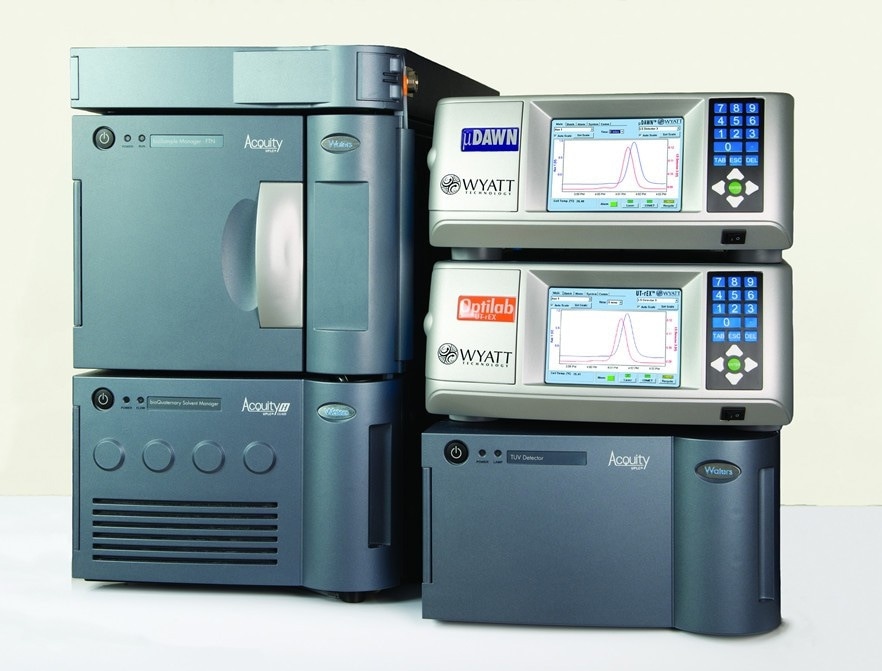In a recent post, Viet Pham addressed the question of 'Which chromatography detector should I buy'. Although Viet provided an excellent overview of different options available for different types of chromatography, he only briefly alluded to the most significant type for those running gel-permeation chromatography (GPC) or size-exclusion chromatography (SEC): multi-angle light scattering (MALS).

The Problem with SEC/GPC
Most types of analytical chromatography rely on column calibration by means of reference molecules. The standards can be run, retention time can be calibrated based on the molecular property, molecules can be injected, and the properties of these molecules can be estimated by interpolating the retention time plot.
This is a reasonable approach for most types of chromatography, and is not prone to too many sources of systematic error. This tried and tested methodology is universal to a large subset of analysis. However, SEC/GPC column calibration is subject to major sources of systematic error, because the separation principle is only loosely associated with the parameter being measured.
The mechanism of size exclusion chromatography is just that - it separates based on size, specifically by hydrodynamic volume, and due to diffusion into and out of pores in the stationary phase smaller molecules elute later than larger molecules.
Most practitioners would actually like to measure molecular weight, not hydrodynamic volume. For any given macromolecule, the association between hydrodynamic volume and molecular weight depends on density and conformation. Compared to compact molecules such as branched polymers, linear polymers show a different relationship.
Globular proteins have a different relationship than partially disordered proteins, peptides, or multi-domain complexes with extended tertiary structures. Therefore, if there is no similarity between samples and reference molecules in terms of density or conformation, then column calibration using typical standards such as globular proteins or linear polymers will lead to incorrect measurements.
Are you Special?
Some types of samples such as PEGylated, co-polymers, or glycosylated proteins lack appropriate calibration standards, or there may not be a reference molecule that is appropriate for your mobile phase. In addition, non-ideal column interactions can affect retention time and skew SEC column calibration.
Non-steric interactions such as electrostatic and hydrophobic are some of the common examples of such non-ideal behavior. In the case of large, branched polymers, anchoring of the branches in the GPC packing pores causes larger molecules to elute later, reversing the predicted elution order.
While mass spectrometry following LC certainly provides accurate molecular weights, it has a number of limitations including the inability to represent the actual solution behavior. Heterogeneous samples can produce a real mass spec mess, and non-covalently bound oligomers often appear in their monomeric form in mass spec.
The Solution
So, what are the measures that need to be taken by a chromatographer to achieve reliable, accurate, solution-based molar mass measurements? Wyatt Technology say the solution is Light(TM). MALS can be defined as a first-principles measurement of the size and molar mass of macromolecules in solution.
It does not rely on column calibration (This should not be confused with Evaporative Light Scattering, which enables measuring concentration and is always used with column calibration). The combination of SEC and MALS results in a SEC-MALS system, where the only function of the column is to effect separation, allowing MALS to measure molecules of a single size at any given elution time.
As long as good separation is achieved, SEC-MALS does not care how the sample interacts with the column. This leads to accurate and reliable results, even if the chromatography is between mobile phases or not repeatable run-to-run – no recalibration is required.
A complete SEC-MALS system features an online MALS detector, an industry-standard HPLC instrument set, and an online concentration, usually based on differential refractive index (dRI) or UV absorption. If you are running Waters' APC for polymers or UHPLC-SEC for proteins, compatible dRI detectors and small-volume MALS are available.
All Masses, Great and Small

All masses, great and small.
SEC-MALS is capable of covering a huge range of molar mass, from 200 g/mol to hundreds of millions, in fact much larger than may be separated by SEC. A different separation method must be used for larger nanoparticles and macromolecules, as well as any other molecules that do not work well with columns.
Asymmetric Flow Field-Flow Fractionation (AF4) is considered to be the most versatile size-based separation technology that is integrated with MALS. It separates nanoparticles and macromolecules from 1 nm to ~1000 nm and provides resolution that is as good as, if not better, than SEC for most species. AF4 is also the method of choice for a wide range of analytes.
Beyond Molar Mass
In addition to providing absolute, first-principles measurements of molar mass, SEC-MALS also defines molecular size and conformation and analyzes conjugated molecules such as copolymers, glycoproteins, and protein-carbohydrate complexes.
Size and Conformation
For molecules with an rms radius (Rg) greater than 10 nm, MALS simultaneously measures size with molar mass. Additionally, the combination of size and molar mass of heterogeneous polymers creates a conformation plot, which can be interpreted to understand whether a polymer is branched or linear, and the extent of branching.
The ratio of size to molar mass will also reveal whether a protein is partially disordered, fully folded, or denatured, and this can be compared with electron microscopy and SAXS data to assess the shape of an extended complex.
If molecules are smaller than 10 nm, their size can be measured with differential viscometry or dynamic light scattering (DLS). As this technique also employs a flow cell and laser beam, the MALS can be integrated with online DLS, eliminating the requirement for an additional detector that adds dispersion to the chromatographic peaks. Generally, but not always, DLS is employed for the more compact proteins and viscometry for polymers.
Conjugates and Co-Polymers
As no appropriate reference standards are available, column calibration cannot be used to characterize conjugated proteins and co-polymers. The three-detector system: SEC-UV-MALS-RI is the primary means for the molecules characterization. The combined signals are examined to define the molecular weight of the two constituent species, such as carbohydrate and protein or two types of polymers, and also the total molecular weight.
Another set of molecules that are not amenable to column calibration are surfactant-solubilized membrane proteins, which can also be characterized by SEC-UV-MALS-RI. Absolute determination of the true oligomeric state of a protein in solution, be it a membrane or other type of protein, is an important application of SEC-MALS in the field of life sciences.

Misjudging the mass can lead to a dire outcome!
Characterize with Confidence
Technologists and scientists require reliable and repeatable values of molecular properties, which can be useful to them. Recognizing the fact that all measurement methods are subject to sources of random, bias, and systematic error, we can do the best we can to reduce such errors.
Biochemists and analytical chemists using GPC or SEC and who have also adopted MALS to determine absolute size and molar mass view their molecules in a whole new light - with new-found confidence in the outcomes and extended characterization capabilities.

This information has been sourced, reviewed and adapted from materials provided by Wyatt Technology.
For more information on this source, please visit Wyatt Technology.